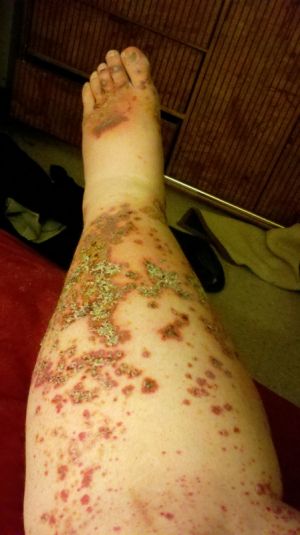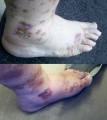Difference between revisions of "Leukocytoclastic vasculitis"
m |
|||
| Line 20: | Line 20: | ||
| − | + | *symptoms | |
*stages (rash/itch, purpura/sensitivity, RLS from hell (acid needle), oozing/ice pick hypersensitivity | *stages (rash/itch, purpura/sensitivity, RLS from hell (acid needle), oozing/ice pick hypersensitivity | ||
*hypersensitivity, screaming | *hypersensitivity, screaming | ||
*malaise, insomnia | *malaise, insomnia | ||
*Scare with bloody underwear | *Scare with bloody underwear | ||
| − | |||
*blood in all pieces of clothing.... *sigh* | *blood in all pieces of clothing.... *sigh* | ||
*bloody socks are a regular thing. | *bloody socks are a regular thing. | ||
Revision as of 21:01, 27 June 2013
| This article is a stub. I'll get around to lengthening it when I feel like it :) |
TL;DR
For the TL;DR crowd: In February I developed a condition called leukocytoclastic vasculitis, which is essentially a disease where the immune system decides your blood vessels are foreign invaders and attempts to destroy them. It appears to be chronic, however, there doesn't appear to be internal organ involvement, and it looks like we're finally getting it under control with oral steroids.
2013-06-27: *Deep breath* Here goes...
When your dermatologist hands you a copy of the page from her reference book and you see the first line describing your condition includes "small-vessel necrotizing vasculitis", the teenage boy in you reading his mom's medical encyclopedia starts shouting "Cool! I have something with necrotizing in the description!", but then the middle-aged man in you kicks in and says "YOU FOOL! DON'T YOU UNDERSTAND THAT MEANS DEATH! YOUR OWN IMMUNE SYSTEM IS OUT TO KILL YOU!" However, the teenager mumbles under his breath as he grabs the keys for the new car and dodges out the door, "I still think it's cool."
|
About a week after my friend Jana came to visit me in February, I started getting small red spots around my knee. They itched and so at first I thought they might be bedbug bites, since I had spent nearly two months in hotels since November from the field tests at Savannah River National Lab and after I totalled my car in Iowa. A week later, it had spread across to the other leg and became more of an itchy rash on my thigh. In the beginning of March, I had spots on my left hand and swelling and joint stiffness in my hands. At this point, the spots on my legs started turning purple and started coalescing. A week later, a secondary infection had set in on my right leg and the spots were turning black. At this point, when I showed our secretary, she told me "Go to an emergency room NOW!" This finally made me take it seriously and I went to see my doctor, who then referred me to a dermatologist. The dermatologist instantly recognized it and told me it was leukocytoclastic vasculitis, giving me the above page from her reference manual. We started a course of oral antibiotics to fight the secondary infection and started topical steroids and antibiotics to try to bring it under control.
At this point, I took two weeks of sick leave then switched over to half-time sick leave for the next month. (Yay for benefits!) Due to the swelling in the legs, I was on bedrest much of this time, which led to the spread of the rash form up onto my back, arms, and lower abdomen.
Expressions I've experienced since, aside from the rash and lesions, include leaking blisters (bullae), blisters that dry up and give you fun times playing with the dry hockey pucks floating under your skin, and ulcerations. (The ulcerations take the longest to heal.)
- symptoms
- stages (rash/itch, purpura/sensitivity, RLS from hell (acid needle), oozing/ice pick hypersensitivity
- hypersensitivity, screaming
- malaise, insomnia
- Scare with bloody underwear
- blood in all pieces of clothing.... *sigh*
- bloody socks are a regular thing.
- causes
Biopsy results
On 2013-05-10 I went in to a surgeon to get a two-punch biopsy on a fresh lesion. The biopsy results indicated the following:
|
|
Translation: "Yeah, it's leukocytoclastic vasculitis, but we don't have a clue what's causing it." The rheumatologist gave the analogy of being set down from a balloon in the middle of a cornfield. You know you are in a cornfield, but you don't have a clue what country you are in.
What does this mean? Well, it means we have a definite diagnosis on LV, but we do not know the initial trigger. In approximately 50% of the cases, they never find out a trigger, so I don't have my hopes up. Through blood and urine tests, we have largely ruled out systemic (internal organ) involvement, so that is a Good ThingTM.
|
Epidemiology
The occurrence of leukocytoclastic vasculitis in adults is rare. Studies in the UK, Spain, etc. have shown rates ranging from 10-40 adults per million per year. Anecdotally my dermatologist sees about ten cases per year (including children) and my rheumatologist has seen about 10 cases in his entire career. While a the surface these seem contradictory, it's not. The dermatologist's numbers include children where it is known as Henoch-Schönlein purpura. Dermatologists are usually the first line of defense and the condition is often only referred to a rheumatologist when it becomes apparent that it is likely chronic. My understanding is that, in children, the condition usually goes away quickly and is rarely chronic.
- Leukocytoclastic Vasculitis Images
- Images of my progress with leukocytoclastic vasculitis
2013-03-17
Left leg the day before my birthday. I didn't photograph my other leg at the time because I was just trying to show mom the LV itself, not the secondary infection that had set in on the right leg. Also, I was in intense pain, so I wasn't exactly thinking about chronicling.2013-04-22
The beginning of the third round of LV outbreaks. This was the one that prompted my dermatologist to turn me over to a rheumatologist, since it was starting to look like a chronic condition.2013-05-24
The beginning of the fourth round of LV outbreaks. You can see how large the third round ankle spot got.2013-06-20
Fourth round of LV outbreaks is finally healing after treatment with oral steroids. You can see the swelling has gone down considerably between the previous picture and this one.





